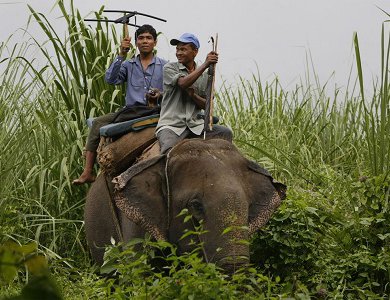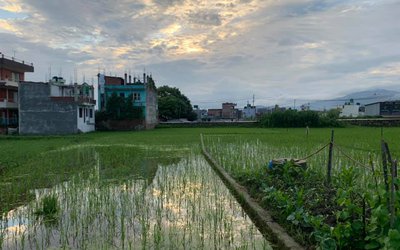
Conservation of natural environment has become one of the key elements or foundation of sustainable development. Globally, the importance of wildlife has been increasing day by day. In broad sense, wildlife comprises all living organisms (plants, animals, micro-organisms) in their natural habitats which are neither cultivated/domesticated nor tamed. But in its strictest sense, it includes uncultivated mammals, reptiles, birds and fishes etc. which are generally hunted based on the rules and regulation of concerned government and international conventions.
Importance of wildlife can be categorized in various aspects. Wildlife helps to maintain the ecological balance. Moreover, it balances population and maintains food-chains and natural-cycles which include(a) regulation of population of different species by self-regulation and feedback, (b) food-chains or passage of food and energy through series of populations comprising producers, consumers and micro-organisms, and(c) natural cycles or circulation of inorganic nutrients between biotic and abiotic environments, prevention of leaching and run-off.
Wildlife preserves gene bank. The direct relationship of preservation of wildlife to human progress is its significance as gene banks for breeding programs. Man is the only species who has widely used the hidden values of a wide range of species around him. A species once lost cannot be retrieved. Therefore, it would be ethical to be responsible for the conservation of a species. We have an evolutionary responsibility to conserve biological diversity for our descendants.
Wildlife can clean the environment. Scavengers and decomposers such as wild animals (like vultures, eagles, jackals, hyenas etc.) as well as micro-organisms, which feed upon dead animals, convert them into different nutrients and release energy back to the nature increasing fertility of the soil. Researcher are using wild animals for experiments with in code of conduct. Some of the experimental animals are Monkeys, Rabbits, Guinea-pigs, and Rats etc. For research purposes and studies of anatomy, physiology, ecology, evolutionary aspects; wild animals are used, which help in saving human life.Next, if we protect wildlife we are protecting forests. It means we are combating land degradation and making the environment clean, green and healthy. Regarding the economic importance of wildlife,one can obtain skin, furs, musk, ivory etc. from wildlife which are valuable in the global market and allow marketing based on the rules of the country and international conventions.
Besides these, benefits are also obtained from tourists, exports of wildlife and its parts, hunting of surplus stock, procurement of food materials, hide, ivory etc. after death of wild animals(except legally banned species).Wildlife has huge potential uses. Just as all present day domesticated animals are derived from wildlife; new foods, beverages, drugs and other useful products may be obtained in future from wildlife under the legal arrangement of the governments.
The land and the natural resources are limited but the numbers of people / mouths to feed are going up and up. It is really very difficult task to protect, conserve and allocate land to the wildlife.This is possible through the concept of multiple-use of the land. Firstly, along with the tree planting on bunds, some game birds like quails, partridge, and jungle fowl etc. which are harmless to the agricultural crops and live in agricultural fields are reared or left there.As a result, the villagers may be often allowed to hunt them and taking fees. In this way; from agricultural fields, in addition to agricultural crops, benefits may be taken as fuel wood, fodder, timber, hunting etc. also. It will serve the purposes of conservation of rare and threatened species, soil and water conservation, and enhancement of our economy up to a certain extent.
The lands which are not suitable for agriculture and horticultureor have unique valuesare being used for forestry and wildlife. But when there is scarcity of agricultural/horticultural lands, forest or wild land are being utilized officially or unofficially. There is a growing concern about multiple use of forestry. Without deforesting the forest land, wildlife can be reared. Under such circumstances, seeing the importance of wildlife, it may be linked with other land-uses in such a way that the revenue from the main land-use may be meeting and simultaneously wildlife may also be conserved and farmed imparting benefits to the mankind.
National bird Daphne, Rhinos, Tigers, Elephants, Red Panda, Snow Leopards, Wild Buffalos, Swamp deer, Musk deer, Birds, Peacocks, Butterflies, Owls, Pangolins, Snakes, Fishes, Crocodiles, Dolphins and such faunal capital are indicators of nature conservation. Based on the landscape and uniqueness, forest or other lands can be used for wildlife conservation. Wildlife farming is encouraged by the government. Time has come to conserve and farm wildlife in community forest, collaborative forests and other types of forests. At the same time, human- wildlife relations must be maintained. Not only Federal government, Provincial and Local governments must allocate sufficient budget for the protection, conservation, and management of wildlife resources. It will help to meet the nation's mission- "Prosperous Nepal, Happy Nepali" and global goals – Sustainable Development Goals.
Paudyal can be is former Vice- President of Nepal Foresters' Association. He can be reached at bijayarajpaudyal711@gmail.com

Bijaya Raj Paudyal
Paudyal is General Secretary of Sinamangal Urban Service Society, Kathmandu Municipal-32
- Gene Conservation For Sustainable Future
- May 31, 2021
- Can Nepalese Foresters Revive Their Lost Agenda?
- Apr 12, 2021
- Fire The Uncontrolled Forest Fire
- Mar 29, 2021
- Nepal's Agenda : Simsar Conservation
- Jan 26, 2021
- Conservation Politics And Our Heroes
- Sep 23, 2020












